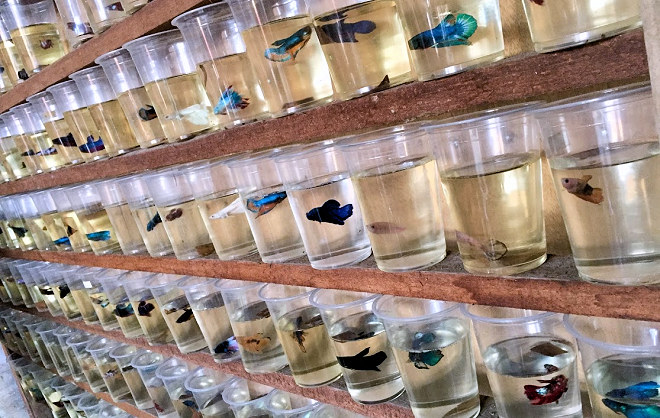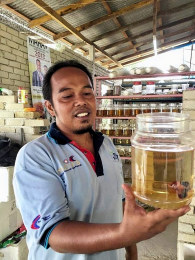Aie Betta Lover Farm

The ornamental fish trade is a multibillion-dollar industry in which approximately more than 125 countries are involved in the trade. The global Ornamental fish trade is estimated to be more than US$ 15 billion and more than 2 billion live ornamental fishes are traded. In Malaysia, ornamental fish trade had a value of 15,574,093US$ in 20172. 99% of the global market is confined to hobbyist and less than 1% is used for public aquaria and research institutes. Developing countries are the major producers and suppliers in the world supplying more than 60% of the ornamental fish. Over 2,500 species are involved in the global ornamental fish industry, of which over 60% are of freshwater origin and the rest are marine.
 Ornamental fish trade also involves larger numbers of wild caught
fish and invertebrates, in addition to the much popular farm reared
ornamental fishes. The ornamental fish sector is primarily dependent
on freshwater fish species, with nearly 15% of the total traded
species being marine, contributed by wild collections. One of the
most common ornamental fish is Betta sp. A total of 73 kinds of
Betta live in freshwater environments of Southeast Asia, and all of
these varieties belong to the family Osphronemidae. But the species
most people are familiar with is Betta splendens.
Bettas are a member of the gourami family. These Bettas
originate from the Mekong and Chao Phraya river basins in Thailand
(formerly called Siam). The fish hang out in shallow, nearly
stagnant waters, such as marshes, flood plains and rice paddies. In
the wild, the animals feed on insects that fall into the water, as
well as small crustaceans, mosquito larvae and other aquatic
arthropods.
Ornamental fish trade also involves larger numbers of wild caught
fish and invertebrates, in addition to the much popular farm reared
ornamental fishes. The ornamental fish sector is primarily dependent
on freshwater fish species, with nearly 15% of the total traded
species being marine, contributed by wild collections. One of the
most common ornamental fish is Betta sp. A total of 73 kinds of
Betta live in freshwater environments of Southeast Asia, and all of
these varieties belong to the family Osphronemidae. But the species
most people are familiar with is Betta splendens.
Bettas are a member of the gourami family. These Bettas
originate from the Mekong and Chao Phraya river basins in Thailand
(formerly called Siam). The fish hang out in shallow, nearly
stagnant waters, such as marshes, flood plains and rice paddies. In
the wild, the animals feed on insects that fall into the water, as
well as small crustaceans, mosquito larvae and other aquatic
arthropods.
Betta fish, more commonly known as Siamese Fighting Fish, are Anabantoids and a member of the Gourami family. This sub-order belongs to freshwater fish species characterised by their ray-fins and possession of a lung-like labyrinth organ, a supplemental breathing structure, which enables Betta to breath in air on surface using these unique organs, also referred to as labyrinth. The labyrinth organ is developed between 3 and 6 weeks in the young fish. The air is forced into the labyrinth organ, to allow the oxygen to be absorbed. Within the labyrinth, cavities are many small maze-like compartments of thin boney plates called lamellae. Thus, Betta could survive in low oxygenated water, a plus trait for aquarium hobbyist as the tank that holds them in does not have to be supplied with continuous aeration. Ideal water temperature (as in tropical regions) can range between 24-28 degrees celcius; in colder water they are more prone to illness7. The lifespan of betta fish is 2-5 years and can grow up to 7cm in length.
Although aquarium specimens are widely known for their brilliant colors and large, flowing fins, the natural coloration of B. splendens is generally dull green, brown and grey, and the fins of wild specimens are short. In the wild, they exhibit strong colors only when agitated. In captivity, they have been selectively bred to display a vibrant array of colors and tail types. Wild populations are listed as Vulnerable by the IUCN.
 The male fish are known to be very aggressive even to their own
kind and commonly reared individually. Males in particular are prone
to high levels of aggression and will attack each other if housed in
the same tank. If there is no means of escape, this will usually
result in the death of one or both of the fish. Female Bettas can also become
territorial towards each other if they are housed in too small an
aquarium. It is typically not recommended to keep male and female
Bettas together, except temporarily for breeding purposes which
should always be undertaken with caution. During courtship, male will
flash its colourful long fin to attract the female. When the mating
occurs, female will deposit eggs onto the male’s tail and the male
will fertilize the eggs shortly after. The eggs will be picked
and cared by the male in the bubble nest that the male built on
surface of water. The female will then be removed to another tank or
risk being attacked by the male. Incubation period for Betta eggs
will take approximately 36 hours although this can be impacted by
changes in temperature. The Betta will stay in endogenous phase for
approximately 3-4 days, and live feed will often be given before the
egg yolk are fully depleted. The male and the young will be
separated to different tanks. Betta colours may change markedly
during their grow-out stage and become more territorial as they
approach maturity. The Betta fish will start to show their
unique colours between 8 and 9 weeks.
The male fish are known to be very aggressive even to their own
kind and commonly reared individually. Males in particular are prone
to high levels of aggression and will attack each other if housed in
the same tank. If there is no means of escape, this will usually
result in the death of one or both of the fish. Female Bettas can also become
territorial towards each other if they are housed in too small an
aquarium. It is typically not recommended to keep male and female
Bettas together, except temporarily for breeding purposes which
should always be undertaken with caution. During courtship, male will
flash its colourful long fin to attract the female. When the mating
occurs, female will deposit eggs onto the male’s tail and the male
will fertilize the eggs shortly after. The eggs will be picked
and cared by the male in the bubble nest that the male built on
surface of water. The female will then be removed to another tank or
risk being attacked by the male. Incubation period for Betta eggs
will take approximately 36 hours although this can be impacted by
changes in temperature. The Betta will stay in endogenous phase for
approximately 3-4 days, and live feed will often be given before the
egg yolk are fully depleted. The male and the young will be
separated to different tanks. Betta colours may change markedly
during their grow-out stage and become more territorial as they
approach maturity. The Betta fish will start to show their
unique colours between 8 and 9 weeks.

Aie Betta Lover fish farm is a small freshwater ornamental fish breeding company owned by a local in a small town in Peninsular Malaysia. What started as just a fish keeping hobby for an IT consultant, has expanded into a business production of variety of freshwater fish such as Betta, Molly and Swordtail. Betta prices can fetch up to RM 900 for a pair or 200 USD depending on the type and variety. Customers select the fish based on the colour variety as well as the fins: the caudal fin has been ‘modified’ in selective breeding techniques, as well as the vibrant colours, which do not exist in nature.
Aie Betta Lover farm operation includes 3 small compartments: one houses the main fish exhibition area or holding unit, the other
two, hatchery for breeding and a nursing area. It is mainly run by
the owner of the company (photo on the right) with local university students from Kuala
Terengganu as part time workers.
Although it is crucial for the farm production, the farm does not operate a dedicated live feed production to support its production. The live feed of preference, Moina, is usually sourced from local supplier or caught by the owner himself from its natural habitat in neighbouring area. However, the amount of Moina available often fluctuates, and there is not enough to meet the demands. Moina contain high protein content (up to 50%) and are suitable for fry or adult Betta. As a freshwater live feed, they can co-exist well with Betta in Betta holding container and similar to Betta, they can also tolerate low oxygen levels. Under optimum culture conditions, Moina culture can peak in 4-7 days of culture. From Betta Lover Farm perspective, he does not have the enough manpower and capacity to operate live feed culture including the microalgae culture set up.